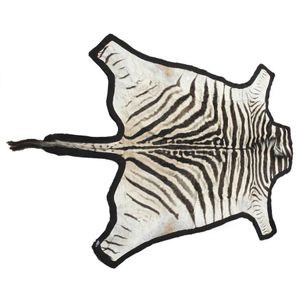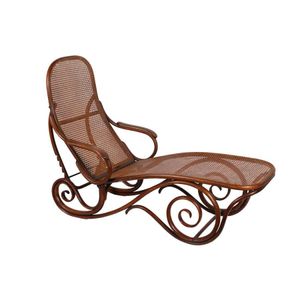Mahogany Library Armchair with Zebra Upholstery
George II style mahogany library armchair, 19th century, upholstered in zebra mohair, the scrolled arm terminating in eagle heads, raised on carved cabriole legs, height 100 cm
You must be a subscriber, and be logged in to view price and dealer details.
Subscribe Now to view actual auction price for this item
When you subscribe, you have the option of setting the currency in which to display prices to $Au, $US, $NZ or Stg.
This item has been sold, and the description, image and price are for reference purposes only.
- Cabriole Leg - The cabriole leg evolved from an elongated scroll, curving out at the knee which may or may not be carved, and forming a serpentine shape as it descends to the foot.
First introduced into English furniture in the late 17th century, cabriole legs were widely used during the Queen Anne and early Georgian periods, where they frequently terminated in a pad foot or ball and claw foot. The style has had many imitators since then. The cabriole leg was re-introduced in the mid-19th century, and is commonly associated with the balloon-back dining or drawing-room chairs made in walnut, mahogany or, in Australia, cedar. The Victorian cabriole leg, on the whole, was rather more slender than the earlier form, following the French style, which emphasized the delicacy and daintiness of the chairs they were designed to support. Cabriole legs are sometimes found on windsor chairs, especially those made during the 18th century. - The Eagle - The eagle has been a symbol of power, victory, and strength for centuries. It is often associated with bravery, prowess, and dominance, and has been used as a symbol by many cultures and civilizations throughout history.
In ancient Greece, the eagle was associated with the god Zeus, who was considered the king of the gods and the ruler of the skies. In many cultures, the eagle was seen as a messenger between the physical world and the spirit world, and was associated with the sun and the sky.
In the Roman Empire, the eagle was the symbol of the Roman army, and was displayed on the standards of the soldiers to show the power and authority of the empire. In medieval Europe, the eagle was used as a symbol of power and victory by monarchs and rulers, and was often depicted in art and architecture as a symbol of strength and courage.
In modern times, the eagle continues to be a symbol of power, victory, and strength. It is often used as a symbol by nations and organisations, and is frequently depicted in art and on monuments to commemorate important events and achievements.
The eagle's powerful appearance, combined with its association with freedom, courage, and dominance, makes it a popular and enduring symbol of power and victory. - George Ii - George II (1683 - 1760) was King of Great Britain and Ireland from 1727 until his death in 1760.
- Mohair - Mohair is a type of fabric or yarn that is made from the hair of the Angora goat. Mohair is known for its softness, luster, and durability, and it is often used in high-end fashion and textile products.
The Angora goat is native to Turkey, but it is now raised in many parts of the world, including South Africa, the United States, and Australia. The goats are sheared twice a year to harvest their long, silky hair, which can be up to 30 cm (12 inches) in length.
The hair is then spun into yarn, which can be woven or knitted into fabrics for clothing, blankets, and other textiles. Mohair is often blended with other fibers, such as wool or silk, to improve its strength and texture.
Mohair is prized for its softness, which comes from the fine, tightly curled fibers of the Angora goat's hair. The fibre is also naturally lustrous, with a shiny, almost metallic appearance. Mohair is also highly durable and resistant to moisture, making it a popular choice for high-end fashion products such as suits, coats, and evening wear. - Mahogany - Mahogany is a dense, close grained red-coloured timber from the West Indies and Central America. It was first imported into Europe in the the early 18th century and its use continued through the 19th century. It was popular for furniture making because of its strength, the wide boards available, the distinctive grain on some boards, termed flame mahogany and the rich warm colour of the timber when it was polished.. The "flame" was produced where a limb grew out from the trunk of the tree, and this timber was usually sliced into veneers for feature panels on doors, backs and cornices.
Some terms used to describe mahogany relate to the country from which it originally came, such as "Cuban" mahogany, "Honduras" mahogany etc. However unless the wood has been tested the names assigned are more a selling feature, rather than a true indication of the timber's origin.
This item has been included into following indexes:
- chairs, singles - Georgian 542
-
chairs, singles / pairs / threes, style or period
- armchairs 1,732
- desk 288
- library 288
- office 288
- Victorian, other styles 1,179
- chairs, singles / pairs / threes, timber - mahogany 1,098
Visually similar items

A painted wooden rocking zebra, 97 cm high, 102.5 cm wide
Sold by
in
for
You can display prices in $Au, $US, $NZ or Stg.

A Burchell's zebra skin rug, the skin backed on to black felt, includes tail and a fraction of mane. Length from tip to tail 250 cm, width from leg to leg 170 cm
Sold by
in
for
You can display prices in $Au, $US, $NZ or Stg.

A mahogany & stripped upholstered rocking chair
Sold by
in
for
You can display prices in $Au, $US, $NZ or Stg.

Bentwood daybed, Austrian 1890's Thonet, with rattan seat and back, adjustable
Sold by
in
for
You can display prices in $Au, $US, $NZ or Stg.
